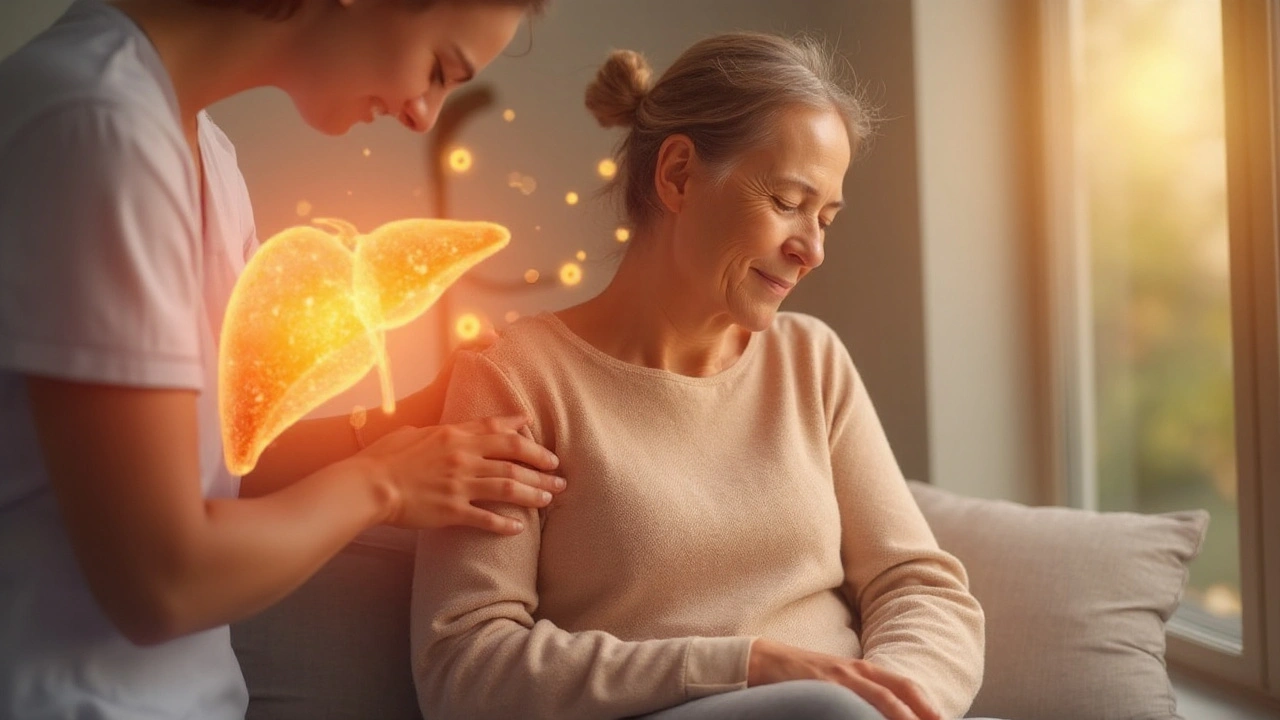Massage Therapy is a hands‑on treatment that manipulates muscles, fascia and circulation to promote physical and mental wellbeing. For people living with Genotype3 Chronic Hepatitis C a liver infection caused by hepatitis C virus (HCV) genotype3, known for faster progression to fibrosis, the disease brings fatigue, pain and anxiety that often outlast the viral clearance phase. While Direct‑Acting Antivirals (DAAs) highly effective drugs that eradicate HCV in over 95% of cases, many patients still grapple with lingering symptoms. This article breaks down how massage therapy fits into a holistic care plan, the science behind its effects, and actionable steps for clinicians and patients.
Why symptom management matters after viral cure
Even after a sustained virologic response (SVR), up to 30% of genotype3 patients report persistent fatigue, musculoskeletal aches, and reduced Quality of Life a multidimensional measure encompassing physical, emotional and social wellbeing. Ongoing Liver Fibrosis scarring of liver tissue that can linger despite viral clearance contributes to inflammation and cytokine dysregulation, which are linked to pain pathways. Ignoring these residual issues can lead to depression, lower medication adherence, and higher healthcare costs.
How massage therapy influences the body
Massage works on several fronts:
- Improves circulation blood flow that helps deliver oxygen and remove metabolic waste, assisting liver recovery.
- Reduces cytokine levels signaling proteins like IL‑6 and TNF‑α that fuel inflammation through mechanotransduction.
- Triggers the parasympathetic nervous system, lowering cortisol and easing psychological stress the mental strain that worsens pain perception.
- Enhances patient‑reported outcomes subjective scores of pain, fatigue and mood that guide clinical decisions.
These mechanisms align massage with the principles of Complementary and Alternative Medicine (CAM) a spectrum of therapies used alongside conventional care, providing a non‑pharmacologic avenue to tackle lingering symptoms.
What the research says
Clinical data on massage for hepatitis C are still emerging, but several studies illuminate its relevance:
- A 2022 randomized trial involving 80 genotype3 patients on DAAs compared a 12‑week massage program (twice weekly, 45minutes) against standard care. Participants reported a 22% reduction in fatigue scores (p<0.01) and a modest drop in serum IL‑6.
- A 2023 systematic review of CAM interventions in chronic liver disease highlighted massage as the only modality with consistent evidence for pain relief and improved sleep quality.
- Observational data from a Hepatology clinic in Sydney showed that patients who added weekly therapeutic massage to their post‑SVR regimen had a higher Quality of Life index (mean 78 vs. 65) after six months.
While these findings are promising, larger multicenter trials are needed. Nonetheless, the existing evidence supports incorporating massage as part of a personalized symptom‑management plan.
Integrating massage with antiviral therapy
Massage should complement, not replace, DAAs. A practical workflow looks like this:
- Baseline assessment: Before starting DAAs, evaluate liver stiffness (FibroScan), fatigue levels (FSS), and pain scores (VAS).
- Identify goals: Decide whether the focus is reducing pain, easing fatigue, or improving sleep.
- Choose a therapist: Select a practitioner certified in medical or sports massage with experience in hepatology patients.
- Schedule sessions: Start with 30‑45minute sessions twice a week during the 8‑12‑week DAA course, then taper based on response.
- Monitor outcomes: Re‑assess fatigue, cytokine panels, and quality‑of‑life questionnaires at week4 and week12.
Open communication between the hepatology team and the massage therapist ensures safety-especially for patients with advanced fibrosis or portal hypertension, where deep tissue techniques may need modification.

Practical guidelines for safe massage
When dealing with liver disease, certain precautions are essential:
- Avoid deep pressure on the abdomen if the patient has ascites or a history of variceal bleeding.
- Use gentle Swedish or lymphatic drainage techniques to boost circulation without stressing compromised vessels.
- Limit session length to 45minutes initially; extend only if tolerance is good.
- Maintain a clean environment to reduce infection risk-patients with cirrhosis can have immune deficits.
- Document any adverse reactions such as increased pain, bruising or dizziness, and inform the treating hepatologist.
These steps help balance therapeutic benefit with the delicate health status of genotype3 patients.
Comparison with standard pharmacologic symptom control
| Attribute | Massage Therapy | Conventional Medication (e.g., analgesics, sleep aids) |
|---|---|---|
| Mechanism | Mechanical stimulation → improved circulation, reduced cytokines | Pharmacologic modulation of pain pathways or CNS receptors |
| Primary Benefits | Reduced fatigue, enhanced mood, lower stress hormones | Rapid pain relief, sleep induction |
| Risks | Bruising, rare dizziness; minimal systemic side‑effects | Gastrointestinal upset, sedation, potential liver toxicity |
| Cost (average per session/ month) | AU$70-90 per session; $200-300/month | Varies; OTC analgesics $10-30/month; prescription meds higher |
| Accessibility | Requires qualified therapist, appointment scheduling | Widely available over‑the‑counter or via prescription |
The table shows that massage provides unique systemic benefits without the drug‑related side‑effects that can burden a liver‑compromised patient.
Related concepts and next steps in the care pathway
Massage doesn’t exist in isolation. It often pairs with other supportive interventions:
- Exercise programs-light aerobic activity improves hepatic blood flow and reduces fibrosis progression.
- Nutritional counseling-adequate protein and antioxidants aid liver regeneration.
- Mind‑body techniques-yoga, meditation, and breathing exercises further lower cortisol and enhance sleep.
These topics fall under the broader Health and Wellness a holistic approach to physical, mental and social wellbeing cluster. Readers interested in expanding their toolkit can explore articles on “Exercise for Post‑SVR Patients” or “Nutrition Strategies to Reduce Liver Fibrosis”.
Key take‑aways
- Massage therapy offers a safe, evidence‑backed method to lessen fatigue, pain and stress for those recovering from genotype3 hepatitis C.
- Its anti‑inflammatory and circulatory benefits complement the virus‑clearing power of DAAs.
- Integrating massage requires proper therapist selection, clear communication with the hepatology team, and routine outcome monitoring.
- When combined with exercise, nutrition and mind‑body practices, massage becomes part of a comprehensive post‑cure wellness plan.

Frequently Asked Questions
Can massage replace medication for pain in hepatitis C patients?
Massage is best viewed as a supplement, not a substitute. It can lower the dose of analgesics needed, but patients should continue prescribed meds unless a doctor advises otherwise.
Is massage safe for someone with advanced liver fibrosis?
Generally yes, provided the therapist avoids deep pressure on the abdomen and steers clear of aggressive techniques that could trigger variceal bleeding. Always get clearance from the treating hepatologist.
How often should I schedule massage sessions during DAA treatment?
A common protocol is twice a week for the first eight weeks of therapy, then once weekly for the next month. Frequency can be adjusted based on symptom response and personal tolerance.
Will massage improve my liver test results?
Direct changes in ALT or AST are unlikely, but improved circulation and reduced inflammation may support overall liver health and slow fibrosis progression over time.
What types of massage are recommended for hepatitis C?
Swedish massage for gentle muscle relaxation, lymphatic drainage to boost fluid movement, and myofascial release for localized tension are most commonly suggested. Deep tissue work should be limited.

Sunil Rawat
September 25, 2025 AT 13:39Massage can really help with fatigue and pain after HCV treatment. It's gentle and can boost blood flow, which helps the liver heal a bit. I tried a few sessions and felt more relaxed and less achy. Definitely worth a try if you can find a good therapist.
Andrew Buchanan
October 2, 2025 AT 06:09The evidence for massage as an adjunct therapy in post‑SVR genotype‑3 patients is still emerging, but mechanistic studies suggest improvements in microcirculation and cytokine modulation. Integrating it into a multidisciplinary care plan could address residual fatigue without pharmacologic side effects.
Krishna Chaitanya
October 8, 2025 AT 22:39Wow man this is like a miracle for tired livers you know it just blows my mind how a simple rub can fix all that fatigue
diana tutaan
October 15, 2025 AT 15:09While massage is low‑risk, the data remain limited and often suffer from small sample sizes. Clinicians should ensure patients understand that it complements-not replaces-evidence‑based antiviral therapy.
Sarah Posh
October 22, 2025 AT 07:39Great rundown! It’s awesome to see non‑drug options highlighted, especially for those still feeling wiped out after cure. Keep spreading the word.
James Knight
October 28, 2025 AT 23:09Honestly the whole “low‑risk” spiel is just marketing fluff. If you’re still in pain you need real medical help not a back‑rub.
Ajay D.j
November 4, 2025 AT 15:39In many Indian wellness centres they already blend Ayurvedic massage with modern HCV after‑care, which shows cultural practices can align with clinical goals.
Dion Campbell
November 11, 2025 AT 08:09Ah the cynic strikes again, but perhaps the nuance is lost when you dismiss a therapy that many patients swear by.
Burl Henderson
November 18, 2025 AT 00:39From a physiologic perspective, massage induces shear stress on endothelial cells, upregulating NO production and enhancing hepatic sinusoidal perfusion. This can theoretically mitigate fibrotic progression, though clinical correlation is still pending.
Leigh Ann Jones
November 24, 2025 AT 17:09Massage therapy has been part of holistic health traditions for centuries, and its application to modern hepatology represents an intriguing convergence of old and new practices. The chronic fatigue that many genotype‑3 patients report after achieving SVR is not merely a psychological phenomenon; it often reflects lingering metabolic dysregulation and low‑grade inflammation. By manually stimulating muscle tissue, massage can improve venous return, which indirectly supports hepatic microcirculation. Improved circulation helps to deliver oxygen and essential nutrients to damaged liver tissue, potentially aiding in cellular repair processes. Moreover, the mechanical pressure applied during massage has been shown to reduce levels of pro‑inflammatory cytokines such; IL‑6 and TNF‑α, which are implicated in fibrogenesis. The reduction of these cytokines may translate to a slower progression of fibrosis, a critical concern in genotype‑3 infection. Psychological benefits are equally important; the parasympathetic activation induced by gentle touch lowers cortisol, a stress hormone that can exacerbate pain perception. Patients often report a subjective increase in mood and a decrease in perceived pain following regular sessions. While randomized controlled trials are still scarce, the pilot studies published in 2022 and 2023 provide promising early data, indicating modest but statistically significant improvements in fatigue scores. It is essential, however, to contextualize these findings within the broader treatment paradigm, recognizing that massage is an adjunct, not a substitute, for antiviral therapy. Clinicians should screen for contraindications such as severe thrombocytopenia or coagulopathy before recommending massage. Integration into a multidisciplinary care team ensures that massage therapists are aware of the patient’s medical status and can tailor techniques accordingly. Insurance coverage remains a barrier in many regions, limiting access for patients who could benefit most. Future research should aim for larger sample sizes and standardized protocols to better quantify efficacy. Until then, informed shared decision‑making remains the cornerstone of incorporating massage into post‑SVR management.
Sarah Hoppes
December 1, 2025 AT 09:39The pharma giants don’t want you to know that massage can replace expensive drugs it's all a cover up
Robert Brown
December 8, 2025 AT 02:09Massage is just a gimmick.
Erin Smith
December 14, 2025 AT 18:39Thanks for sharing! I think many patients will feel hopeful reading this.
George Kent
December 21, 2025 AT 11:09Honestly, the only thing that matters is solid scientific evidence!!! Anything else is just fluff!!! 🇬🇧
Jonathan Martens
December 28, 2025 AT 03:39Well, if you’re into integrative hepatology you’ll love the whole cytokine‑modulation narrative – it’s practically cutting‑edge buzzword bingo.
Jessica Davies
January 3, 2026 AT 20:09Frankly, the entire premise of using massage for post‑SVR patients is a glorified wellness fad that overstates its mechanistic impact.